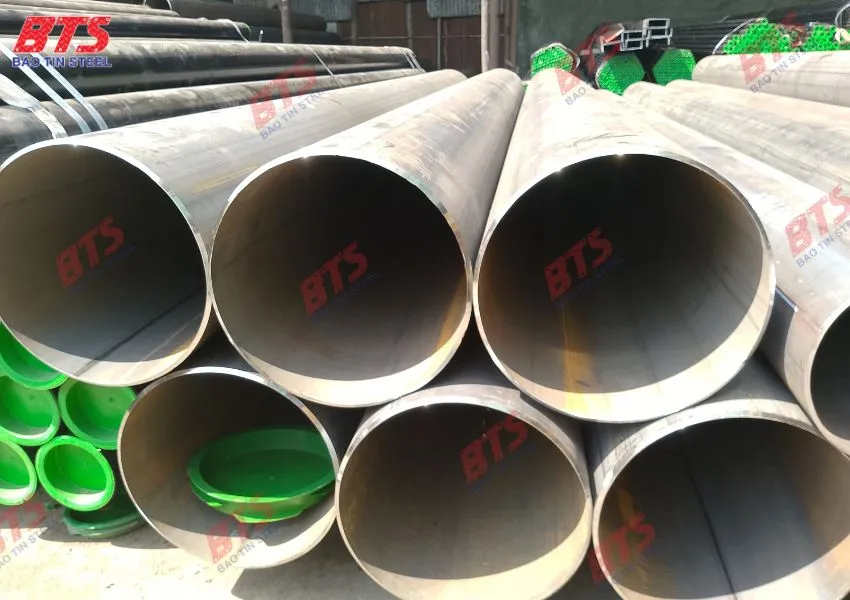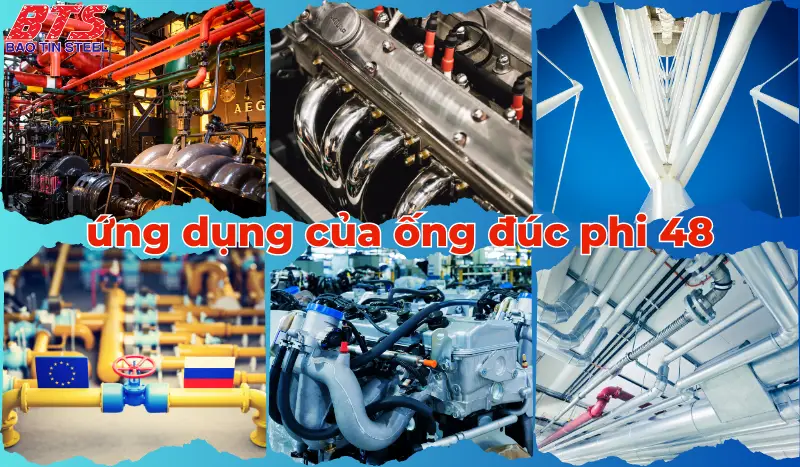Seamless pipes and welded pipes are two types of pipes widely used in construction projects. Each type has its characteristics and applications. So what exactly are those points? See the article below to distinguish between seamless steel pipes and welded steel pipes!
Comparison between cast steel pipes and welded steel pipes
As two different types of pipes, cast steel pipes, also known as seamless steel pipes, and welded steel pipes are different from the most basic things. For example: production materials, production process, mechanical properties, etc. Specifically:
Raw materials for producing cast pipes and welded pipes
| Seamless steel pipes | Welded steel pipes |
| Manufactured from round and solid steel billets. People heat the molten steel billet and then pull it out of the tube billet. Next is to empty the tube. Finally, pull, cut, and straighten according to customer requirements. | Welded pipes are manufactured from steel plates, steel sheets, and rolled steel. People will weld steel plates together. There are two popular welding methods: straight welding and spiral welding |
Processing/manufacturing process of cast and welded pipes
| Seamless steel pipes | ỐWelded steel pipes |
| Round billet → trimming → heating → pressurizing → venting → tapering → measuring diameter → billet tube → straightening → sectioning → Visual inspection → NDT (Non-Destructive Testing: Test method ingredients, materials without damaging the specimen) → mark the number, label/bundle | Remove steel plate → Shape by spiral or straight welding → Smooth seams and welds → Reinforce seams → Customize size → Shape diameter → Cut to required size → Complete. |
Appearance – dimensions of welded pipes and Seamless pipes
Even with the eyes, we can distinguish between seamless steel pipes and welded steel pipes through the characteristics of the pipe body.
| Seamless Steel Pipe | Welded Steel Pipe |
| The pipe body has no weld seams. For most molded pipe manufacturers in China, they produce the original molded pipe size with a maximum outside diameter of 20 inches (508 mm). Cases typically smaller than 16 inches (406.4 mm) due to device limitations will require a few other special machining steps. | The pipe body has welded seams. This tube has no size restrictions. Sizes available from 1-1/2 to 100 inches (48.3mm – 2540 mm). |

Distinguish between the purposes of seamless pipes and welded pipes
With seamless steel pipe
- GB/T8162-1999 (structural cast pipes): Used in common systems. The main raw materials (steel grade) are 20 carbon steel, 45 steel, Q345 alloy steel, 40Cr, 20CrMo, 30-35CrMo, 42CrMo etc.
- GB/3087-1999 (seamless pipes used in low and medium-pressure furnaces): Mainly used in pipe furnaces. Or used to conduct low and medium-pressure solutions. Typically steel 10 and steel 20.
- GB/5310-1995 (used in high-pressure furnaces): Mainly used as solution pipes and water pipes in hydroelectric power stations and nuclear power station heat-resistant furnaces. Typical steel grades are 20G, 12Cr1MoVG, 15CrMoG…
- GB/5312-1999 (shipbuilding industry): Mainly class I and II pressure pipes used in superheated machines. Typical steel is 360,410,460
- GB/1479-2000 (pipes used to conduct high-pressure chemical equipment): Mainly used to conduct high-pressure solutions in chemical equipment. Typical steels are 20.16 Mn, 12 CrMo, 12 Cr2Mo,…
- GB 9948-1988 (Seamless pipes used in petroleum). Used as a solution pipe in oil and gas furnaces. Steel grades used: 20, 12CrMo, 1Cr19Ni11Nb.
- API SPEC5CT-1999 (oil pipe): A common pipe type was announced worldwide by the American Petroleum Association (American Petroleum Institute, API). Telescopic pipes are used to insert into oil wells, and pipes are used as well walls. The main steel used is J55, N80, and P110.
- API SPEC 5L-2000: Pipe type used worldwide, announced by the American Petroleum Association. The main types of steel used are B, X42, X65, X70, etc.


With welded steel pipes
- GB/T3092-1993, GB/T3091-1993 (low-pressure galvanized welded pipe): Mainly used to carry water, gas, air, distillation gas, and low-pressure solutions. The type of steel used is Q235A.
- GB/T14291-1992 (welded pipes carrying mineral solutions): Mainly use straight welded pipes to transport wastewater. The main raw materials are Q235A and B steel.
- GB/T142980-1994 (large diameter welded pipe for low-pressure solution). Mainly used to conduct water, gas, and air. The main raw material is Q235A.
- GB/T12770-1991 (stainless welded pipes used in mechanical structures): Mainly used in mechanical structures, cars, bicycles, and household appliances. Commonly used steels are 0Cr13, 1Cr17, 00Cr19Ni11, 1Cr18Ni9,…
- GB/T12771-1991 (stainless welded pipes used to carry solutions): Main steel grades are 0Cr13, 0Cr19Ni9, 00CrNi11, 00Cr17,…

Compare the cost of seamless steel pipes and welded steel pipes
The price of seamless steel pipes is usually higher than the price of welded steel pipes. The reason is because:
- The production process is more complicated. To produce cast pipes, it is necessary to melt steel billets. This painting requires high technology and heavy machinery. While bending and welding steel plates and sheets is much simpler,.
- Higher quality materials: Seamless steel pipes have higher durability, better load-bearing, and heat resistance thanks to better quality materials.
Should I buy seamless steel pipes or welded steel pipes?
Tiger Steel is a branch of Bao Tin Steel.


 Tiếng Việt
Tiếng Việt ភាសាខ្មែរ
ភាសាខ្មែរ